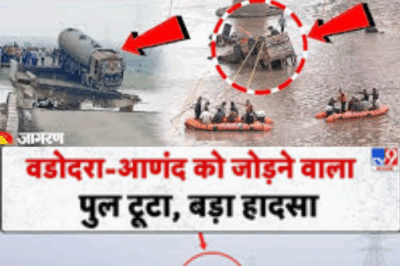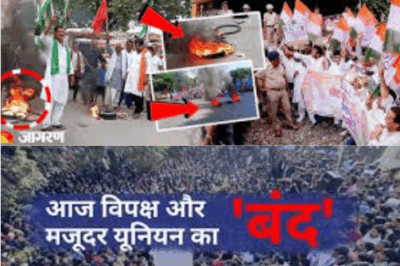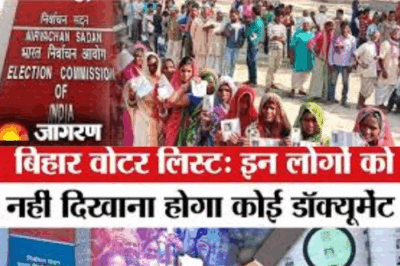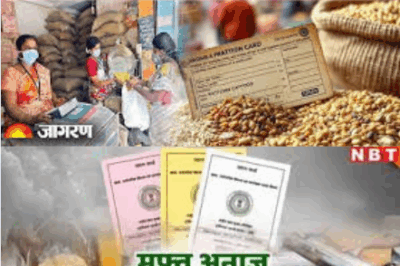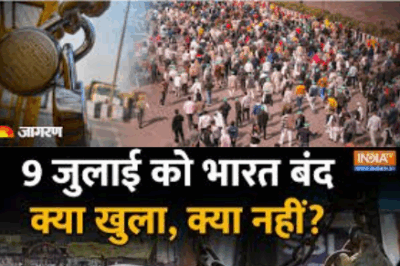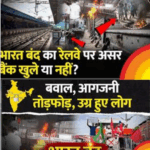Bharat Bandh Update: Indian Railways, Schools, Banks Closed during Bharat Bandh?
On July 9, 2025, India witnessed one of its most significant general strikes in recent years, as ten central trade unions came together to call for a nationwide “Bharat Bandh.” The strike, a coordinated show of strength and solidarity among over 250 million workers, was not just a protest against government policies but a call to action for the rights of laborers, farmers, and the common citizen. The impact of this strike reverberated across sectors—banking, postal services, mining, coal, insurance, electricity, and construction—demonstrating the collective power of India’s workforce and highlighting the deep-seated grievances that have been simmering beneath the surface of the country’s rapid economic growth.
The genesis of the strike lay in a series of demands put forth by the trade unions. At the heart of their protest was a sense of growing disenfranchisement among workers and farmers, who felt that recent government policies were systematically eroding their rights and livelihoods. The unions called for decisive action to tackle unemployment, an increase in the number of workdays and wages under the Mahatma Gandhi National Rural Employment Guarantee Act (MGNREGA), and the creation of more jobs across the economy. They accused the government of enacting and implementing policies that, in their view, favored corporations and the wealthy at the expense of ordinary workers and the rural poor.
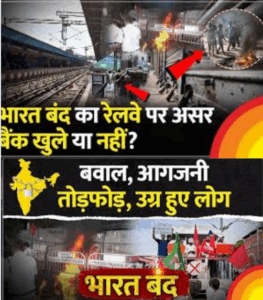
The scale and scope of the strike were unprecedented. Over 250 million workers from diverse sectors joined hands, making it one of the largest industrial actions in the world. The participation of employees from banks, post offices, coal mines, insurance companies, electricity boards, and construction sites underscored the depth of discontent. In many states, public transport services ground to a halt as bus drivers and road transport workers joined the protest. The sight of empty bus stands, long queues of stranded passengers, and highways blocked by striking workers became emblematic of the day’s events.
The impact of the bandh, however, was uneven across the country. In Delhi, the capital city, the strike failed to gain significant traction. Praveen Khandelwal, Member of Parliament from Chandni Chowk and National General Secretary of the Confederation of All India Traders, publicly stated that neither Delhi’s traders nor the business community at large supported the bandh. Markets remained open, daily life continued with few disruptions, and the city’s famed hustle and bustle persisted. This lack of participation from the trading community highlighted a growing divide between organized labor and urban business interests—a divide that has become increasingly pronounced in recent years.
Despite the limited impact in Delhi, the bandh made its presence felt in other parts of the country. In Chandigarh, public transport was severely affected as roadways employees went on strike and staged sit-ins, disrupting the movement of buses and causing hardships for commuters. The city’s usually smooth traffic was replaced by scenes of protestors occupying major intersections, chanting slogans against the government and demanding the fulfillment of their demands. Similar disruptions were reported from Odisha, where bus drivers halted their vehicles in the middle of roads, leaving passengers stranded and agitated. The blockade of buses and the resulting traffic jams led to a cascading effect, with essential supplies like vegetables and milk facing delays and shortages.
West Bengal, a state with a long history of labor activism, also saw a near-total shutdown of bus services. Bus drivers refused to operate their vehicles, leaving bus terminals deserted and passengers frustrated. The widespread participation of transport workers in the bandh underscored the strength of the trade unions in the state and their ability to mobilize large numbers of workers at short notice. The resulting chaos and inconvenience for ordinary citizens, however, also fueled anger and resentment among those who felt caught in the crossfire between labor and the government.
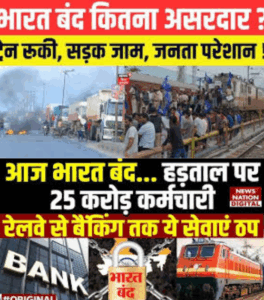
Not all regions were equally affected. In Chennai, the capital of Tamil Nadu, the bandh had little noticeable impact. Both public and private bus services ran smoothly, and there were no reports of major disruptions at bus stands or transport hubs. Passengers went about their routines without difficulty, and the city’s daily rhythm remained largely undisturbed. This regional variation in the impact of the strike reflected the complex and diverse nature of India’s labor movement, as well as the differing degrees of union influence across states.
The participation of the banking sector in the strike was a matter of particular concern for many citizens. While there was no official bank holiday declared, and most banks remained open, services were nonetheless disrupted in several regions. The Bengal Provincial Bank Employees’ Association reported that insurance sector employees might also join the strike, potentially compounding the impact on financial services. Customers faced delays in accessing essential services, and the specter of a prolonged disruption loomed large over those who rely on banks for their daily transactions.
Despite the breadth of the strike, some services remained unaffected. Schools and colleges stayed open, as no official holiday was declared. Children attended classes as usual, and roads leading to educational institutions were not blocked. This decision to keep schools open was a deliberate attempt to minimize the impact of the bandh on students and families, and to ensure that the right to education was not compromised by the ongoing labor unrest.
The Bharat Bandh was as much about symbolism as it was about concrete demands. By bringing the country to a halt, the trade unions sought to send a clear message to the government: the voices of India’s workers and farmers cannot be ignored. The slogans raised by striking employees—demanding job security, higher wages, and the protection of labor rights—echoed through city streets and rural byways alike. The blockade of highways and the formation of long queues of trucks at state borders underscored the interconnectedness of India’s supply chains and the vulnerability of the economy to labor unrest.
The government’s response to the strike was measured. Officials acknowledged the right of workers to protest, but also emphasized the need to maintain essential services and minimize disruption to public life. In some states, authorities worked closely with union leaders to ensure that emergency services and critical infrastructure remained operational. The lack of widespread violence or confrontations was a testament to the largely peaceful nature of the protest, even as passions ran high and tempers flared in some quarters.
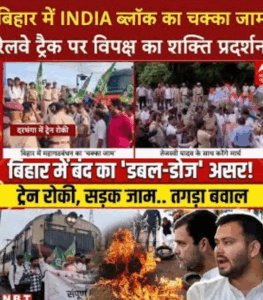
The July 9th strike also highlighted a growing sense of frustration among India’s working class. Many workers feel that their concerns are not being adequately addressed by policymakers, and that the benefits of economic growth are not being shared equitably. The demand for an increase in MGNREGA workdays and wages, in particular, resonated strongly in rural areas, where job opportunities remain scarce and poverty is widespread. The unions’ call for more job creation and the protection of labor rights tapped into a deep well of discontent that has been building for years.
At the same time, the strike exposed the challenges facing India’s labor movement. The lack of support from the business community and the limited impact in major urban centers like Delhi and Chennai pointed to a need for greater coordination and outreach. The ability of unions to mobilize large numbers of workers in some states, but not others, reflected the uneven distribution of organizational strength and the complexities of India’s federal structure.
In the aftermath of the bandh, the focus shifted to the government’s response to the unions’ demands. Will policymakers take meaningful steps to address the concerns of workers and farmers, or will the strike be remembered as just another day of disruption? The answer to this question will have profound implications for the future of labor relations in India, and for the broader struggle for social and economic justice.
The July 9th Bharat Bandh was a stark reminder of the power of collective action and the enduring relevance of trade unions in India’s democracy. It was a day when millions of workers stood up to be counted, when the streets and highways of the nation became arenas of protest and resistance. It was also a day that revealed the fault lines running through Indian society—the gaps between labor and capital, between rural and urban, between the haves and the have-nots. As India moves forward, the lessons of the bandh will continue to shape the country’s politics, its economy, and its ongoing quest for a more just and equitable society.
Play video :
News
Gujarat Bridge Collapse: The bridge connecting Vadodara-Anand collapsed, scary pictures of Gujarat bridge accident
Gujarat Bridge Collapse: The bridge connecting Vadodara-Anand collapsed, scary pictures of Gujarat bridge accident Life often offers us a single…
Bihar Bandh: Trains were stopped, tyres were burnt. Effect of Mahagathbandhan’s Bihar Bandh
Bihar Bandh: Trains were stopped, tyres were burnt. Effect of Mahagathbandhan’s Bihar Bandh On a day charged with tension and…
Bihar Election Update: Voter’s List! EC’s big decision, what to do if you don’t have the document?
Bihar Election Update: Voter’s List! EC’s big decision, what to do if you don’t have the document? As Bihar heads…
Ration Card Update 2025: New rule regarding ration card, these people will not get ration
Ration Card Update 2025: New rule regarding ration card, these people will not get ration The Indian government’s stringent e-KYC…
Chhangur Baba News Updates: Who is Chhangur Baba? Did CM Yogi run the bulldozer?
Chhangur Baba News Updates: Who is Chhangur Baba? Did CM Yogi run the bulldozer? In the early hours of July…
9th July Bharat Band: Bharat Bandh will happen on 9th July! What will be open, what will remain closed?
9th July Bharat Band: Bharat Bandh will happen on 9th July! What will be open, what will remain closed? On…
End of content
No more pages to load

